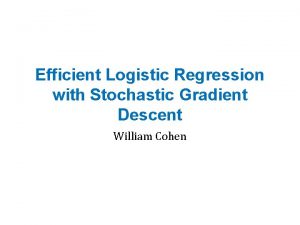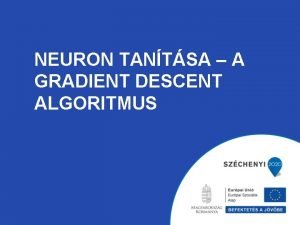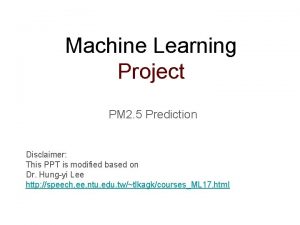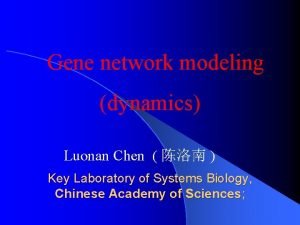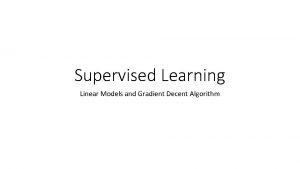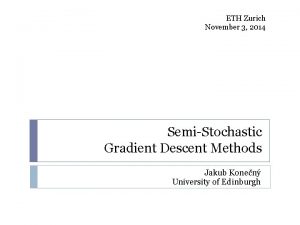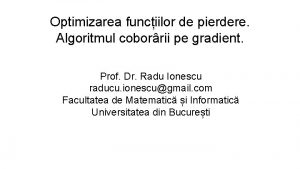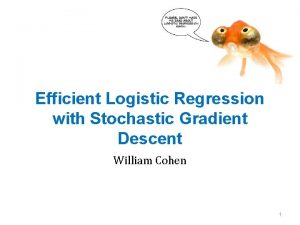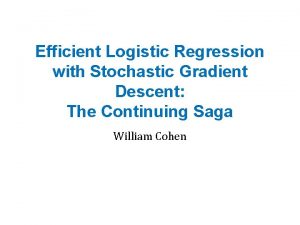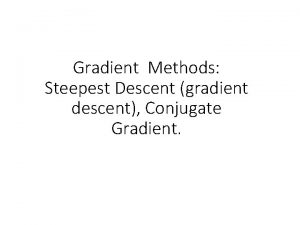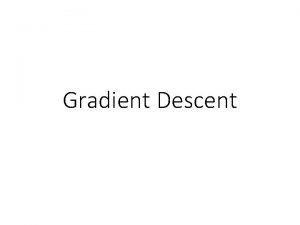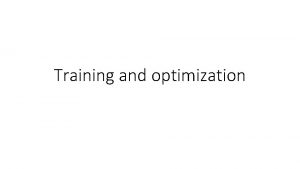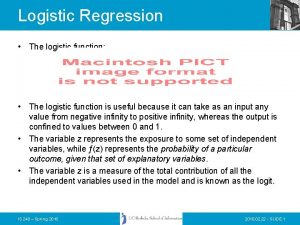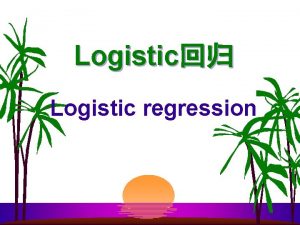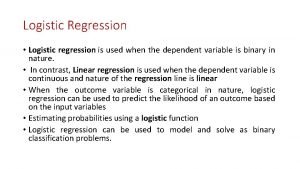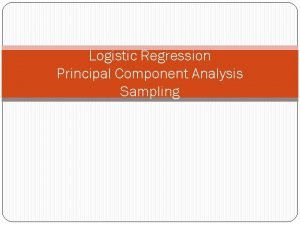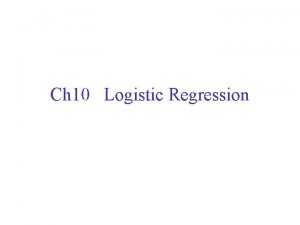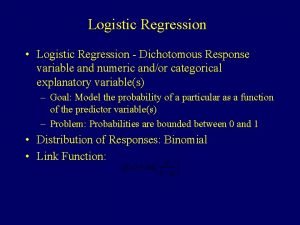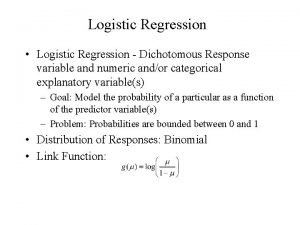Efficient Logistic Regression with Stochastic Gradient Descent William














- Slides: 14

Efficient Logistic Regression with Stochastic Gradient Descent William Cohen

Reminder: Your map-reduce assignments are mostly done Old NB learning • Stream & sort • Stream – sort – aggregate – Counter update “message” – Optimization: in-memory hash, periodically emptied – Sort of messages – Logic to aggregate them • Workflow is on one machine New NB learning • Map-reduce • Map – shuffle - reduce – Counter update Map – Combiner – (Hidden) shuffle & sort – Sum-reduce • Workflow is done in parallel

NB implementation summary Map to generate counter java Count. For. NB train. dat … > event. Counts. dat updates + Sum combiner java Counts. By. Word event. Counts. dat | sort + Sum reducer | java Collect. Records > words. dat java request. Word. Counts test. dat | tee words. dat | sort | java answer. Word. Count. Requests | tee test. dat| sort | test. NBUsing. Requests train. dat id 1 id 2 id 3 id 4 id 5. . w 1, 1 w 1, 2 w 1, 3 …. w 1, k 1 w 2, 2 w 2, 3 …. w 3, 1 w 3, 2 …. w 4, 1 w 4, 2 … w 5, 1 w 5, 2 …. counts. dat X=w 1^Y=sports X=w 1^Y=world. News X=. . X=w 2^Y=… X=… … 5245 1054 2120 37 3 …

Implementation summary java Count. For. NB train. dat … > event. Counts. dat Map java Counts. By. Word event. Counts. dat | sort | java Collect. Records > words. dat Reduce java request. Word. Counts test. dat | tee words. dat | sort | java answer. Word. Count. Requests | tee test. dat| sort | test. NBUsing. Requests words. dat w Counts associated with W aardvark C[w^Y=sports]=2 agent C[w^Y=sports]=1027, C[w^Y=world. News]=564 … … zynga C[w^Y=sports]=21, C[w^Y=world. News]=4464

Implementation summary Map + Identity. Reduce; save java Count. For. NB train. dat … > event. Counts. dat output in temp files java Counts. By. Word event. Counts. dat | sort | java Collect. Records > words. dat Identity Map with two sets of inputs; custom secondary sort (used in shuffle/sort) output looks like this java request. Word. Counts test. dat input looks | tee words. dat | sort | java answer. Word. Count. Requests like this | tee test. dat| sort | test. NBUsing. Requests words. dat found ~ctr to id 1 aardvark ~ctr to id 2 … today ~ctr to idi … Reduce, output to temp w Counts aardvark C[w^Y=sports]=2 agent … aardvark ~ctr to id 1 agent C[w^Y=sports]=… agent ~ctr to id 345 agent ~ctr to id 9854 … ~ctr to id 345 … zynga …

Implementation summary java Count. For. NB train. dat … > event. Counts. dat java Counts. By. Word event. Counts. dat | sort | java Collect. Records > words. dat Identity Map with two sets of inputs; custom secondary sort java request. Word. Counts test. dat | tees words. dat | sort | java answer. Word. Count. Requests | tee test. dat| sort | test. NBUsing. Requests Output: id 1 ~ctr for aardvark is C[w^Y=sports]=2 … id 1 ~ctr for zynga is …. … Output looks like this test. dat id 1 found an aardvark in zynga’s farmville today! id 2 … id 3 …. id 4 … id 5 …. .

Implementation summary java Count. For. NB train. dat … > event. Counts. dat java Counts. By. Word event. Counts. dat | sort | java Collect. Records > words. dat Reduce java request. Word. Counts test. dat | tees words. dat | sort | java answer. Word. Count. Requests | tee test. dat| sort | test. NBUsing. Requests Input looks like this Key Value id 1 found aardvark zynga farmville today ~ctr for aardvark is C[w^Y=sports]=2 ~ctr found is C[w^Y=sports]=1027, C[w^Y=world. News]=564 … id 2 w 2, 1 w 2, 2 w 2, 3 …. ~ctr for w 2, 1 is … … …

Reminder: The map-reduce assignments are mostly done Old NB testing • Request-answer New NB testing • Two map-reduces – Produce requests – Sort requests and records together – Send answers to requestors – Produce requests w/ Map – (Hidden) shuffle & sort with custom secondary sort – Reduce, which sees records first, then requests – Sort answers and sending entities together – … – Reprocess input with request answers – Identity map with two inputs – Custom secondary sort – Reduce that sees old input first, then answers • Workflows are isomorphic • Workflows are isomporphic

Outline • Reminder about early/next assignments • Logistic regression and SGD – Learning as optimization – Logistic regression: • a linear classifier optimizing P(y|x) – Stochastic gradient descent • “streaming optimization” for ML problems – Regularized logistic regression – Sparse regularized logistic regression – Memory-saving logistic regression

Learning as optimization: warmup • Goal: Learn the parameter θ of a binomial • Dataset: D={x 1, …, xn}, xi is 0 or 1 • MLE estimate of θ, Pr(xi=1) – #[flips where xi =1]/#[flips xi ] = k/n • Now: reformulate as optimization…

Learning as optimization: warmup Goal: Learn the parameter θ of a binomial Dataset: D={x 1, …, xn}, xi is 0 or 1, k of them are 1 Easier to optimize:

Learning as optimization: warmup Goal: Learn the parameter θ of a binomial Dataset: D={x 1, …, xn}, xi is 0 or 1, k are 1

Learning as optimization: warmup Goal: Learn the parameter θ of a binomial Dataset: D={x 1, …, xn}, xi is 0 or 1, k of them are 1 =0 θ= 1 k- kθ – nθ + kθ = 0 è nθ = k è θ = k/n

Learning as optimization: general procedure • Goal: Learn the parameter θ of a classifier – probably θ is a vector • Dataset: D={x 1, …, xn} • Write down Pr(D|θ) as a function of θ • Maximize by differentiating and setting to zero
 Gradient descent java
Gradient descent java Stochastic gradient descent
Stochastic gradient descent Linear regression gradient descent
Linear regression gradient descent Logistic regression vs linear regression
Logistic regression vs linear regression Logistic regression vs linear regression
Logistic regression vs linear regression Stochastic gradient langevin dynamics
Stochastic gradient langevin dynamics Kay ousterhout
Kay ousterhout Gradient descent equation
Gradient descent equation Gradient descent python implementation
Gradient descent python implementation Gradient descent multiple variables
Gradient descent multiple variables Gradient descent rule
Gradient descent rule Batch gradient descent
Batch gradient descent Allocative efficiency
Allocative efficiency Allocative efficiency vs productive efficiency
Allocative efficiency vs productive efficiency Productively efficient vs allocatively efficient
Productively efficient vs allocatively efficient
